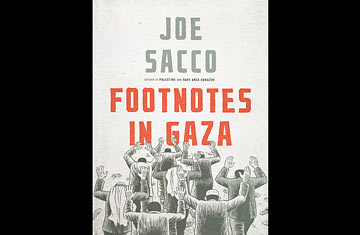
Joe Sacco Footnotes in Gaza
(2 of 2)
In a way that eludes most linear print stories about Gaza, Sacco's drawings capture not only the despair of its benighted citizens, but also their indomitable vitality, their generosity and their gallows humor. "Palestinians in Gaza haven't had the luxury of pulling back and examining the past," Sacco told TIME in a telephone interview, explaining why he had exhumed these ancient events. "Besides, in Gaza, every generation has its own '56."
His investigations hone in on two events in November 1956: first, in the town of Khan Younis, where U.N. records and eyewitnesses say that Israeli soldiers herded around 275 Palestinian men out of their homes, lined them up against the wall of a 14th century castle and executed them. This was in retaliation for attacks on nearby Israeli kibbutzim. Then, several days later, in Rafah, another 100 or so Palestinians were shot and clubbed down as thousands were marched to a barbed-wire pen in a schoolyard for interrogation by Israelis hunting for renegade Egyptian soldiers and Fedayeen guerrillas. The Israelis deny that either event was a massacre, disputing the casualty figures and suggesting their soldiers killed smaller numbers of Palestinians in the course of suppressing riots and other resistance.
One theme running through Sacco's chronicle is what he calls, "the frailty of memory". Sacco does his best to sort out the contradictory testimony, made hazy by the passage of time and successive repeats of similar traumas over the decades. The survivors of the Rafah killings, for example, all remember the appearance of a flock of doves soon before they were freed, but they can't recall if the birds settled on the shoulders of the officer who appeared to demand the Palestinians' release, or if the doves hovered above the officer's head, or if their uniformed savior was Israeli, British or even a French woman from the U.N.
Despite his focus on the past, the present invariably comes crashing in. Sacco and his fixers are shot at by an invisible Israeli sniper in a watchtower. They meet a man who pleads with militants not to use his home as a firing position because the result will be the destruction of his house; and they witness a Rafah home demolished by an Israeli bulldozer that "scooped out the earth as if it were ice cream." Back in 1956, the Palestinians saw the faces of the Israeli soldiers bursting into their homes, but today, in Sacco's cartoons — as well as in reality — Gazans seldom if ever see their enemy, who fires on them from inside tanks, helicopters and other mechanized cocoons.
Sacco's stay in Gaza involves several encounters with militants, haggard, sleep-deprived men always on the run from informers and Israeli assassinations. One of them, "Khaled", comes to a telling realization: "Okay, I hate the Jews but I can live with them." As Sacco tells TIME, "This was a strange and almost hopeful moment — that people who didn't like each other could still live side by side." Most of all, says Sacco, "You meet many people who aren't caught up in rage and anger, they just want a normal life." And it is these ordinary people of Gaza — teachers, merchants and family men — all trying to survive in the midst of the lopsided battle between Palestinian jihadis and the Israeli army, that Sacco brings indelibly to life. In his Footnotes he has helped Gazans regain their memory and, through it, their bruised proud collective identity.
